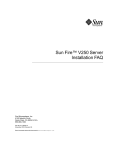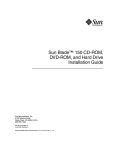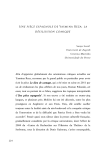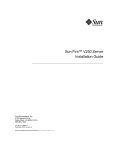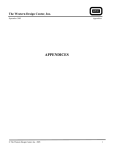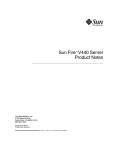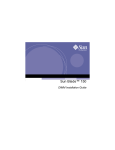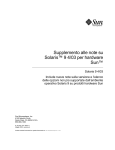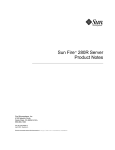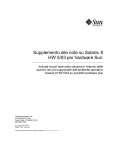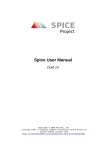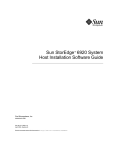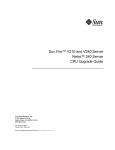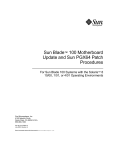Download Sun Fire V250 Server Product Notes
Transcript
Sun Fire™ V250 Server Product Notes Sun Microsystems, Inc. 4150 Network Circle Santa Clara, CA 95054 U.S.A. 650-960-1300 Part No. 817-1003-12 November 2003, Revision A Send comments about this document to: [email protected] Copyright 2003 Sun Microsystems, Inc., 4150 Network Circle, Santa Clara, California 95054, U.S.A. All rights reserved. Sun Microsystems, Inc. has intellectual property rights relating to technology embodied in the product that is described in this document. In particular, and without limitation, these intellectual property rights may include one or more of the U.S. patents listed at http://www.sun.com/patents, and one or more additional patents or pending patent applications in the U.S. and in other countries. This document and the product to which it pertains are distributed under licenses restricting their use, copying, distribution, and decompilation. No part of the product or of this document may be reproduced in any form by any means without prior written authorization of Sun and its licensors, if any. Third-party software, including font technology, is copyrighted and licensed from Sun suppliers. Parts of the product may be derived from Berkeley BSD systems, licensed from the University of California. UNIX is a registered trademark in the U.S. and other countries, exclusively licensed through X/Open Company, Ltd. Sun, Sun Microsystems, the Sun logo, AnswerBook2, docs.sun.com, and Solaris are trademarks, registered trademarks, or service marks of Sun Microsystems, Inc. in the U.S. and other countries. All SPARC trademarks are used under license and are trademarks or registered trademarks of SPARC International, Inc. in the U.S. and other countries. Products bearing SPARC trademarks are based upon an architecture developed by Sun Microsystems, Inc. The OPEN LOOK and Sun™ Graphical User Interface was developed by Sun Microsystems, Inc. for its users and licensees. Sun acknowledges the pioneering efforts of Xerox in researching and developing the concept of visual or graphical user interfaces for the computer industry. Sun holds a non-exclusive license from Xerox to the Xerox Graphical User Interface, which license also covers Sun’s licensees who implement OPEN LOOK GUIs and otherwise comply with Sun’s written license agreements. Use, duplication, or disclosure by the U.S. Government is subject to restrictions set forth in the Sun Microsystems, Inc. license agreements and as provided in DFARS 227.7202-1(a) and 227.7202-3(a) (1995), DFARS 252.227-7013(c)(1)(ii) (Oct. 1998), FAR 12.212(a) (1995), FAR 52.227-19, or FAR 52.227-14 (ALT III), as applicable. DOCUMENTATION IS PROVIDED “AS IS” AND ALL EXPRESS OR IMPLIED CONDITIONS, REPRESENTATIONS AND WARRANTIES, INCLUDING ANY IMPLIED WARRANTY OF MERCHANTABILITY, FITNESS FOR A PARTICULAR PURPOSE OR NON-INFRINGEMENT, ARE DISCLAIMED, EXCEPT TO THE EXTENT THAT SUCH DISCLAIMERS ARE HELD TO BE LEGALLY INVALID. Copyright 2003 Sun Microsystems, Inc., 4150 Network Circle, Santa Clara, California 95054, Etats-Unis. Tous droits réservés. Sun Microsystems, Inc. a les droits de propriété intellectuels relatants à la technologie incorporée dans le produit qui est décrit dans ce document. En particulier, et sans la limitation, ces droits de propriété intellectuels peuvent inclure un ou plus des brevets américains énumérés à http://www.sun.com/patents et un ou les brevets plus supplémentaires ou les applications de brevet en attente dans les Etats-Unis et dans les autres pays. Ce produit ou document est protégé par un copyright et distribué avec des licences qui en restreignent l’utilisation, la copie, la distribution, et la décompilation. Aucune partie de ce produit ou document ne peut être reproduite sous aucune forme, parquelque moyen que ce soit, sans l’autorisation préalable et écrite de Sun et de ses bailleurs de licence, s’il y ena. Le logiciel détenu par des tiers, et qui comprend la technologie relative aux polices de caractères, est protégé par un copyright et licencié par des fournisseurs de Sun. Des parties de ce produit pourront être dérivées des systèmes Berkeley BSD licenciés par l’Université de Californie. UNIX est une marque déposée aux Etats-Unis et dans d’autres pays et licenciée exclusivement par X/Open Company, Ltd. Sun, Sun Microsystems, le logo Sun, AnswerBook2, docs.sun.com, et Solaris [AND ATTRIBUTION OF ALL OTHER SUN TRADEMARKS MENTIONED SIGNIFICANTLY THROUGHOUT PRODUCT OR DOCUMENTATION. REMOVE THIS TEXT!] sont des marques de fabrique ou des marques déposées de Sun Microsystems, Inc. aux Etats-Unis et dans d’autres pays. Toutes les marques SPARC sont utilisées sous licence et sont des marques de fabrique ou des marques déposées de SPARC International, Inc. aux Etats-Unis et dans d’autres pays. Les produits protant les marques SPARC sont basés sur une architecture développée par Sun Microsystems, Inc. L’interface d’utilisation graphique OPEN LOOK et Sun™ a été développée par Sun Microsystems, Inc. pour ses utilisateurs et licenciés. Sun reconnaît les efforts de pionniers de Xerox pour la recherche et le développment du concept des interfaces d’utilisation visuelle ou graphique pour l’industrie de l’informatique. Sun détient une license non exclusive do Xerox sur l’interface d’utilisation graphique Xerox, cette licence couvrant également les licenciées de Sun qui mettent en place l’interface d ’utilisation graphique OPEN LOOK et qui en outre se conforment aux licences écrites de Sun. LA DOCUMENTATION EST FOURNIE "EN L’ÉTAT" ET TOUTES AUTRES CONDITIONS, DECLARATIONS ET GARANTIES EXPRESSES OU TACITES SONT FORMELLEMENT EXCLUES, DANS LA MESURE AUTORISEE PAR LA LOI APPLICABLE, Y COMPRIS NOTAMMENT TOUTE GARANTIE IMPLICITE RELATIVE A LA QUALITE MARCHANDE, A L’APTITUDE A UNE UTILISATION PARTICULIERE OU A L’ABSENCE DE CONTREFAÇON. Please Recycle Sun Fire V250 Server Product Notes This document contains late-breaking news which was not available at the time the beta documentation went to press. It contains the following: ■ “Online Documentation” on page 2 ■ “System Software Requirements” on page 2 ■ “Required and Recommended Patches” on page 2 ■ “Reinstalling the Solaris Operating Environment” on page 2 ■ “Unpacking the Server” on page 3 ■ “Replaceable Component Part Numbers” on page 4 ■ “Using Hard Disk Drives in Single-Ended Mode” on page 4 ■ “Audio” on page 4 ■ “Replacing the Battery” on page 5 ■ “System Power Rating” on page 5 ■ “Replacing the SCSI Backplane” on page 5 ■ “Replacing the Cable Kit” on page 6 ■ “Known Issues” on page 7 ■ “Automatic System Recovery (ASR)” on page 12 1 Online Documentation Online documentation is available at the following URL: http://www.sun.com/products-n-solutions/hardware/docs Check this site periodically for the latest versions of the product documentation. System Software Requirements The Sun Fire V250 server requires Solaris 8 7/03, Solaris 9 8/03 or later. The server is supplied with Solaris 8 7/03 software preinstalled. To identify the software installed on your system, use the cat /etc/release command: # cat /etc/release Solaris 8 HW 7/03 s28s_hw3wos_04 SPARC Copyright 2003 Sun Microsystems, Inc. All Rights Reserved. Assembled 21 May 2003 Required and Recommended Patches There are none at present. Reinstalling the Solaris Operating Environment To reinstall the Solaris operating environment onto a Sun Fire V250 server, refer to the Solaris Installation Guide (806-0955) and the Solaris Advanced Installation Guide (806-0957). 2 Sun Fire V250 Server Product Notes • November 2003 Unpacking the Server Unpack the server carefully and take care not to damage the packaging material. Do not discard the packaging material, it will be needed if you need to repack the server in future. Ship kit Packing Protective wrapper Sun Fire V250 server Packing Carton FIGURE 1 Sun Fire V250 Server Packaging 3 Replaceable Component Part Numbers The part numbers listed in the Sun Fire V250 server platform documentation for two components are incorrect. The table below lists the components and the correct part numbers. TABLE 1 Part Number Corrections Component Book / Section Correct Part Number 36 GB hard disk drive Parts Replacement Manual, 817-0901-10 Table 1-2 Administration Guide, 817-0900-10 “Replaceable Components” on page 16 F540-4904 DAT drive Parts Replacement Manual, 817-0901-10 Table 1-2 F390-0027 Tape Drive in RMD0 If you place a SCSI tape drive in the lower slot (RMD0), set its SCSI ID to 4. Using Hard Disk Drives in Single-Ended Mode The Sun Fire V250 server is qualified for hard disk drives running in LVD mode only. If you insert a hard disk drive which operates in SE mode, the internal bus will automatically switch to SE mode to avoid damage, but it is possible that the hard disk drive will not function. Audio The Sun Fire V250 Server does not support the audiotool. 4 Sun Fire V250 Server Product Notes • November 2003 Replacing the Battery When replacing the battery, always use a type identical to that removed. Replacing the battery should be carried out by service providers only. System Power Rating The power rating stated on the system label is 6A. That figure will be updated to a new system rating, detailed below: ■ ■ One PSU fitted: 7.1A maximum at 100VAC 60 Hz Two PSUs fitted: 7.6A total at 100VAC 60 Hz (3.8A per PSU) Replacing the SCSI Backplane Caution – This section is for the attention of service providers only. This section supplements the SCSI backplane removal procedure documented in the Sun Fire V250 Server Parts Replacement Manual. ■ ■ Before removing the SCSI backplane, remove the system configuration card reader module. After replacing the SCSI backplane, ensure that you reconnect the front fan power cables correctly: ■ ■ The cable for the bottom fan (FT1) attaches to the plug at the top of the SCSI backplane. The cable for the top fan (FT2) attaches to the plug at the bottom of the SCSI backplane. 5 Replacing the Cable Kit This section provides additional procedures for replacing the cable kit. It supplements the information provided in the Sun Fire V250 Server Parts Replacement Manual. ▼ To replace the SCSI cable (SCSI backplane to system board) 1. Remove PCI card support arm. 2. Bend back the two cable retaining hooks to release cable. 3. Replace SCSI cable. 4. Bend cable retaining hooks back into place to secure cable. 5. Replace PCI card support arm. ▼ To replace the DAT cable (SCSI backplane to tape drive) 1. Remove the tie-wrap that secures the DAT cable to the power distribution board wiring loom. 2. Disconnect the cable from the DAT drive. 3. Disconnect the two connectors from the SCSI backplane. 4. Replace cable. 5. Fit new tie-wrap. ▼ To replace the cable assembly (SCSI backplane to system board) 1. Disconnect two connectors, one from each of the following: ■ 6 SCSI backplane Sun Fire V250 Server Product Notes • November 2003 ■ system board 2. Replace cable. 3. Replace connectors. ▼ To replace the cable assembly for power I2C 1. Disconnect two connectors. 2. Replace cable. 3. Replace connectors. ▼ To replace the cable assembly IDE cable 1. Remove the cable from two plastic retaining clips. 2. Disconnect cable from DVD drive. 3. Disconnect cable from system board. 4. Replace cable. 5. Resecure the cable into the two plastic clips. ▼ To replace the blower cable 1. Remove front blower. 2. Replace cable. 3. Replace front blower. Known Issues Caution – Sharp edges may exist. Take care when handling the server, particularly when replacing internal components or carrying out other service procedures. 7 Caution – Low voltage energy is present in the SCSI back plane when the server is powered on. Do not touch the SCSI back plane with the server powered on. Front Service Indicator If the front service indicator is lit and ALOM is reset, the indicator does not come back on. However, the original condition which caused the indicator to come on could still exist. Removal Of Power Supply Not Detected If you remove a PSU with the system running, the PSU must remain out of the chassis for twelve seconds in order for its absence to be detected by system software. ALOM nettest Fails If ALOM is configured to use DHCP but fails to negotiate a lease with the DHCP server, nettest can fail. obdiag Hangs the I2C Bus if a 33 MHz Card Occupies Slot 5 of the Server This issue only occurs when a PCI card running with a clock speed of 33 MHz occupies slot 5 of the server. If a 33 MHz PCI card occupies slot 5 and obdiag is run, the I2C bus and ALOM might hang. This issue presents itself during server reset or reboot, when either of the following messages might appear as a result of the I2C bus hanging: ■ No space left on device ■ NOTICE: could not read from ICS951601 If you encounter either of these messages, you must disconnect power to the server in order to reset the I2C bus and ALOM. 8 Sun Fire V250 Server Product Notes • November 2003 I2C Bus Locks Resetting the ALOM using scadm resetsc can lock up the I2C bus. If that happens then you will get the following error messages during early ALOM boot sequence: ALOM ALOM ALOM ALOM - Could Could Could Could not not not not get get get get all data from I2C - min post, no power on diag-switch from I2C power-state from I2C previous state from I2C Because of this, no ALOM POST will be performed. However, when ALOM finishes initializing, the I2C bus will be unlocked and normal operation will resume. SunVTS Test Probe Failure The SunVTS test probe may fail with segmentation violation when a DVD-RW disk is inserted in the DVD drive. If this happens, use the DVD-ROM media for testing the DVD drive. RamTest Lock Option May Cause System Panic The memory locking option may cause a system panic due to the use of libkvm to tune some kernel variables. This is not a standard interface to tune the kernel. You should instead modify /etc/system openprom Driver Panics There is a problem in the openprom driver causing the system to panic if the kmem_debug flag is set. To prevent this problem occurring do not set the kmem_debug flag. Hard Disk Drive Service LED As the Sun Fire V250 server does not feature a service LED on its hard disk drives, ignore the status reported by ALOM for that component. 9 Operation Mode Switch The operation mode switch is represented in PICL by a devices table beneath a location called SYSCTRL. As this location is never occupied by a FRU, Sun Management Center shows the ’Occupancy’ of the SYSCTRL location as ’Empty’. System Hangs With The Message ’automountd not running, retrying’ Attempting to switch the run-level from single user mode to multi-user mode by using the init command results in the system hanging with the message: automountd not running, retrying To avoid this problem, use the reboot command instead of the init command. Local Disk Is Not Always Mapped To c0t0d0s0 For Each New OS Installation The logical device names may appear differently on your system, depending on the number and type of add-on disk controllers installed. DVD Drive Power Management If you attempt to access a DVD drive within a fraction of a second of its power being removed, the drive is not restarted. An indication of this condition is the message: WARNING: Drive not ready before set_features 10 Sun Fire V250 Server Product Notes • November 2003 Wrong DIMM Shown As Failed By prtdiag If POST disables a pair of DIMMs as a result of its testing, prtdiag might show only one DIMM as disabled, and the other as unused. To see the true state of both DIMMS use the .asr command at the ok prompt. Type: ok .asr SCC IDPROM Corrupted During XIR Testing The reset -x command is intended only to debug systems that are otherwise unresponsive. A system whose operation has been interrupted by reset -x will be in a non-deterministic state and not all features can be guaranteed to work correctly. In particular, attempting to set configuration variables could cause corruption of the non-volatile storage that holds the values of the variables. When the machine is in this state, issue only essential debugging commands . ASR Fails To Disable A PCI Slot On OBDiag Failure This issue applies to PCI cards with ■ ■ a PCI bridge above the card functions built-in selftest If the selftest fails, the ASR framework does not correctly identify the PCI slot that has failed, so cannot mark it as failed. The card can be disabled manually by typing the following before booting: ok asr-disable 11 Misleading error msg displayed when updating OBP with Operation Mode Switch Set To Locked The OBP flash-update procedure might fail with the message: Check the CPU board jumper J???? Note – This message is given before any action has been taken, so the machine is still safe to use. This situation can be caused by having the operation mode switch set to Locked. If it is, set the operation mode switch to Normal and try the flash update procedure again. Incorrect fan failure message If SunVTS executes the env6test with the fan sub-test enabled, there is a possibility of the following error being incorrectly reported: ENCLOSURE_FAN @ FT<x>.F<x>.RS has FAULTED. If you see this error message and you are running Sun VTS with the fan subtest enabled, then you can ignore the message. Automatic System Recovery (ASR) Note – Automatic System Recovery (ASR) is not the same as Automatic Server Restart, which the Sun Fire V250 server also supports. Automatic System Recovery (ASR) consists of self-test features and an autoconfiguring capability to detect failed hardware components and unconfigure them. By doing this, the server is able to resume operating after certain non-fatal hardware faults or failures have occurred. If a component is one that is monitored by ASR, and the server is capable of operating without it, the server will automatically reboot if that component should develop a fault or fail. 12 Sun Fire V250 Server Product Notes • November 2003 ASR monitors the following components: ■ Memory modules If a fault is detected during the power-on sequence, the faulty component is disabled. If the system remains capable of functioning, the boot sequence continues. If a fault occurs on a running server, and it is possible for the server to run without the failed component, the server automatically reboots. This prevents a faulty hardware component from keeping the entire system down or causing the system to crash repeatedly. To support such a degraded boot capability, the OpenBoot firmware uses the 1275 Client Interface (via the device tree) to mark a device as either failed or disabled, by creating an appropriate status property in the device tree node. The Solaris operating environment will not activate a driver for any subsystem so marked. As long as a failed component is electrically dormant (not causing random bus errors or signal noise, for example), the system will reboot automatically and resume operation while a service call is made. Note – ASR is disabled by default. Auto-Boot Options The auto-boot? setting controls whether or not the firmware automatically boots the operating system after each reset. The default setting is true. The auto-boot-on-error? setting controls whether the system will attempt a degraded boot when a subsystem failure is detected. Both the auto-boot? and auto-boot-on-error? settings must be set to true to enable an automatic degraded boot. ■ To set the switches, type: ok setenv auto-boot? true ok setenv auto-boot-on-error? true Note – The default setting for auto-boot-on-error? is false. Therefore, the system will not attempt a degraded boot unless you change this setting to true. In addition, the system will not attempt a degraded boot in response to any fatal nonrecoverable error, even if degraded booting is enabled. For examples of fatal nonrecoverable errors, see “Error Handling Summary” on page 14. 13 Error Handling Summary Error handling during the power-on sequence falls into one of the following three cases: ■ If no errors are detected by POST or OpenBoot Diagnostics, the system attempts to boot if auto-boot? is true. ■ If only non-fatal errors are detected by POST or OpenBoot Diagnostics, the system attempts to boot if auto-boot? is true and auto-boot-on-error? is true. Note – If POST or OpenBoot Diagnostics detects a non-fatal error associated with the normal boot device, the OpenBoot firmware automatically unconfigures the failed device and tries the next-in-line boot device, as specified by the boot-device configuration variable. ■ If a fatal error is detected by POST or OpenBoot Diagnostics, the system will not boot regardless of the settings of auto-boot? or auto-boot-on-error?. Fatal non-recoverable errors include the following: ■ ■ ■ ■ ■ All CPUs failed All logical memory banks failed Flash RAM cyclical redundancy check (CRC) failure Critical field-replaceable unit (FRU) PROM configuration data failure Critical application-specific integrated circuit (ASIC) failure Reset Scenarios Three OpenBoot configuration variables, diag-switch?, obdiag-trigger, and post-trigger, control how the system runs firmware diagnostics in response to system reset events. The standard system reset protocol bypasses POST and OpenBoot Diagnostics unless diag-switch? is set to true. The default setting for this variable is false. Because ASR relies on firmware diagnostics to detect faulty devices, diag-switch? must be set to true for ASR to run. For instructions, see “To Enable ASR” on page 15. To control which reset events, if any, automatically initiate firmware diagnostics, use obdiag-trigger and post-trigger. For detailed explanations of these variables and their uses, see "Controlling POST Diagnostics" on page 55 and "Controlling OpenBoot Diagnostics Tests" on page 59. 14 Sun Fire V250 Server Product Notes • November 2003 ASR User Commands You can use the OpenBoot commands .asr, asr-disable, and asr-enable to obtain ASR status information, manually unconfigure system devices, and reconfigure system devices, respectively. ▼ To Enable ASR 1. At the system ok prompt, type: ok setenv asr-policy normal 2. Type: ok reset-all The system permanently stores the parameter change. Note – To store parameter changes, you can also power cycle the system using the front panel on/standby button. ▼ To Disable ASR 1. At the system ok prompt, type: ok setenv asr-policy service In service mode, ASR flags faulty devices as disabled but still creates an entry in the device tree. The auto-boot will be disabled if a fault is detected, but when you manually boot the system to Solaris all devices present in the device tree will be available. 2. Type: ok reset-all 15 The system permanently stores the parameter change. Note – To store parameter changes, you can also power cycle the system using the front panel on/standby button. ▼ To Obtain ASR Status Information ■ At the system ok prompt, type: ok .asr In the .asr command output, any devices marked disabled have been manually unconfigured using the asr-disable command. The .asr command also lists devices that have failed firmware diagnostics and have been automatically unconfigured by the OpenBoot ASR feature. Unconfiguring a Device Use the OpenBoot firmware command asr-disable to unconfigure system devices manually, allowing a degraded boot capability. This command marks the specified device as disabled by creating an appropriate status property in the device tree node. The Solaris operating environment will not activate a driver for any device so marked. 16 Sun Fire V250 Server Product Notes • November 2003 ▼ To Unconfigure a Device 1. At the system ok prompt, type: ok asr-disable device-identifier where the device-identifier is any device from the list given by typing the following at the ok prompt: ok asr-list-keys Note – The device identifiers are not case-sensitive; you can type them as uppercase or lowercase characters. Manually unconfiguring a CPU causes the entire CPU/Memory board to be unconfigured. You can determine full physical device paths by typing: ok show-devs The show-devs command lists the system devices and displays the full path name of each device. You can display a list of current device aliases by typing: ok devalias You can also create your own device alias for a physical device by typing: ok devalias alias-name physical-device-path where alias-name is the alias that you want to assign, and physical-device-path is the full physical device path for the device. Note – If you manually unconfigure a device alias using asr-disable, and then assign a different alias to the device, the device remains unconfigured even though the device alias has changed. 17 2. To cause the parameter change to take effect, type: ok reset-all The system permanently stores the parameter change. Note – To store parameter changes, you can also power cycle the system using the front panel Power button. Reconfiguring A Device Manually You can use the OpenBoot asr-enable command to reconfigure any device that you previously unconfigured with asr-disable. ▼ To Reconfigure A Device 1. At the system ok prompt, type: ok asr-enable device-identifier where the device-identifier is one of the following: ■ ■ ■ Any full physical device path as reported by the OpenBoot show-devs command Any valid device alias as reported by the OpenBoot devalias command Any device identifier from the following table Note – The device identifiers are not case-sensitive; you can type them as uppercase or lowercase characters. 18 Sun Fire V250 Server Product Notes • November 2003




















